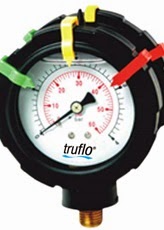When it comes to flow control, the paddle wheel flow meters
hold several advantages over many other flow control systems. The most obvious
of these advantages is evident in their low maintenance costs. In particular,
the Truflo Paddle Wheel Flow Meter
requires very little in terms of installation, operation and performance making
it one of the most cost efficient flow meters in the market today.
How does it work?

The Truflo PaddleWheel Flow Meter consists of three main parts; the pipefittings,
an LCD display screen and a paddle wheel sensor. The paddle wheel sensor can be
found inside the pipe fitting and the paddle itself goes halfway into the flow
stream. The paddle wheel gets spun by any fluid that flows within the pipe and
as this happens, the magnets attached to the paddle also spin. As the magnets
continue spinning past the paddlewheel sensor, electrical pulses directly
proportional to the rate at which the fluid is flowing are also produced. The numbers
of output electrical pulses produced per corresponding volumes are published as
the K-factor.
In addition to the above, which constitute the principal
components of the flow meter, the Truflo
Paddle Wheel Flow Meter has a number of additional features that further
set it above the rest. These include the following;
-
Vertical and horizontal installation; the paddle
wheel’s operation is not affected by gravity and any other factors that would
influence its installation. It can be installed both either vertical or
horizontal positions and still function just as well.
-
High impact polycarbonate cover and rugged
design; both of these features make the Truflo flow meter is a very hardy device
that can withstand a lot of pressure and other external elements. It is also
very suitable for use on corrosive materials.
-
Secure; the security of this flow meter is
password protected meaning that no one can re-program or reset it without
password authorization. This feature is very important especially when the flow
meter is being used in sensitive chemical installations where even the smallest
deviations can lead to serious consequences.
Applications of the Truflo
Paddle Wheel Flow Meter
It is hard to list down all the areas where this flow meter
can be installed and used. That said, here are a few areas where it is used
relatively more extensively;
-
Dispensing systems; unlike other flow meters
that use preset timers to allow the flow of a fluid for a given duration, this
paddle wheel flow meter actually measures the exact volume that flows. While in
the former any system problem that affects the flow rate will change the amount
dispensed, such problems do not influence anything in the latter.
-
Chemical metering pumps; when you need to mix
large volumes of chemicals in specific ratios, the Truflo flow meters can come
in very handy. It is a very accurate flow meter that will ensure only the
specified volume of a given chemical goes through, regardless of whether or not
the system has any problems or defects outside the flow meter.
